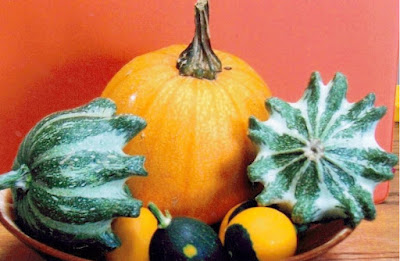 |
| Pumpkin, Big Max Photo: Joyce D'Agostino |
It’s that time of year when pumpkins and winter squash are reaching their peak maturity. These vegetables are not only highly nutritious, but they make wonderful fall decoration displays.
Squash, pumpkin and gourds are in the same genus Cucurbita. Squash includes both a summer types like zucchini and yellow squash and the winter varieties such as butternut and acorn squashes. The summer squash tends to have thinner skins and grow from late spring until late summer. Winter squash and pumpkins are planted in the spring but can take up to 90-100 days to mature.
Before harvesting, it is important to test the skin of your pumpkin or winter squash to see if it is ready. One easy way is known as the ‘thumbnail test’, where you lightly push your fingernail into the skin of the fruit. If your nail easily pierces the skin, then it is not ready to harvest. Once it is difficult to push your nail into the skin of the pumpkin or squash, that is a good indicator that it is mature. The stems of the pumpkin or squash should also turn from a lighter shade to a dark green or brown. Harvest before a hard freeze.
When harvesting, take care not to cut into the fruit. If you do happen to accidentally damage one, just plan to use that one sooner than the others, or cook the pulp or pieces and freeze. Once harvested, you can gently wash and dry each and allow them to cure in a warm area for a few days out of the direct sun and with good air circulation. They can then be placed in a cool dry area such as a basement for storage.
Even if you didn’t grow your own pumpkin or winter squash this year, check the farmer’s markets or grocery stores – often they have a good selection as well and many will keep well in storage. And if you carve your pumpkin for Halloween, be sure to save and roast the seeds for snacking, they are also very nutritious.
The following bulletins will give you good advice on growing, harvesting and storing these important vegetables:






